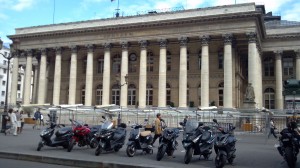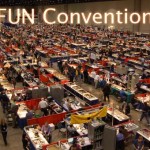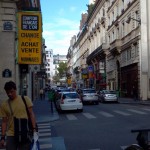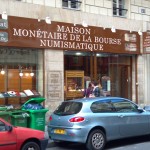Having “F.U.N.” at the Bourse!
 “Bonne année” – Happy New Year, as the French say it. And as usual, the 2013 New Year begins on a happy note in numismatics with the annual F.U.N. show in Orlando, January 9 to 13. The Florida United Numismatists show has the second largest “bourse” of the year, eclipsed only by the World’s Fair of Money, put on each August by the American Numismatic Association.
“Bonne année” – Happy New Year, as the French say it. And as usual, the 2013 New Year begins on a happy note in numismatics with the annual F.U.N. show in Orlando, January 9 to 13. The Florida United Numismatists show has the second largest “bourse” of the year, eclipsed only by the World’s Fair of Money, put on each August by the American Numismatic Association.
 While coin collectors and dealers frequently use the word “bourse,” or “bourse floor,” to refer to the actual trade show area of a coin convention, most people don’t know the origin of the word “bourse.” So in a spirit of “F.U.N.,” let’s take a look!
While coin collectors and dealers frequently use the word “bourse,” or “bourse floor,” to refer to the actual trade show area of a coin convention, most people don’t know the origin of the word “bourse.” So in a spirit of “F.U.N.,” let’s take a look!
“Bourse” is a French word which refers to its “stock exchange.” Actually, there are seven bourse de valeurs, or stock exchanges, in France. The principal exchange is the Bourse de Paris. It is housed in a building known as Palais Brongniart, named after its architect Alexandre-Théodore Brongniart. The building which is shown above was built between 1808 and 1826. It is also known as Palais de la Bourse and is located in the Place de la Bourse – in other words, it’s a palace in a city square.
Trading on the Paris Bourse is done by French stock brokers called “agents de change.” But of course today most operations are computerized. Many American coin enthusiasts would find it interesting and coincidental that the index of the 40 most quoted stocks on the French stock exchange is known as the “CAC,” which stands for the “Cotation Assistée en Continu,” the exchange’s computerized trading system. Similarly in American numismatics “CAC,” which stands for Certified Acceptance Corporation, is a system of designating solid-for-the-grade certified coins that are accepted by some dealers on a sight-unseen trading basis on CoinPlex, CAC’s dealer-only electronic coin trading network.
 The major coin shops in Paris are located in the city blocks surrounding the Paris Bourse. A sign, seen in the accompanying photo, designates this district as a French gold and money trading area. Security is tight and I’m told the narrow
The major coin shops in Paris are located in the city blocks surrounding the Paris Bourse. A sign, seen in the accompanying photo, designates this district as a French gold and money trading area. Security is tight and I’m told the narrow  streets in this district are patrolled by policemen in plain clothes. Typically, these coin shops have a small lobby that customers enter off the street and business is done by passing coins on a tray through a slot under bullet-proof glass. There is no browsing through retail coin stores as we normally see here in the U.S.
streets in this district are patrolled by policemen in plain clothes. Typically, these coin shops have a small lobby that customers enter off the street and business is done by passing coins on a tray through a slot under bullet-proof glass. There is no browsing through retail coin stores as we normally see here in the U.S.
So, while we have our “bourse floors” at coin conventions here in the U.S., “coin shows” are also sometimes known as “coin expos,” and in Britain they are known as “coin fairs.”
So whatever word you want to use to refer to these numismatic trading events – “bourse,” “fair,” “show,” “expo,” or “convention,” they are sure to be “F.U.N.” and lucrative during 2013. The coin market is very strong for scarce and rare vintage coins, and the coin market is reaping economic benefits from an active bullion market. I’ll be scouring the “bourse floor” at next week’s F.U.N. convention looking for coins to buy for customers, so if you have a Want List and would like help at the show finding coins you want to buy – call or email me anytime, even if I may be of help in answering questions for you. Do you have any coins for sale?
Inventory Categories
Recent Articles
- Are You a Rare Coin “Collector,” “Collector/Investor,” or “Investor?”
- Four Ways to Benefit by Giving your “Want List” to a Coin Dealer
- Demand is Strong for Most Areas of the Coin Market
- Now May Be a Very Good Time to Invest in Precious Metals
- Discover and Join the American Numismatic Association if you’re not already a Member




